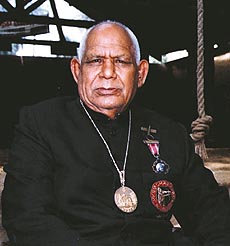Guru par
excellence
By Preeti
Verma Lal
"DEATH is beckoning me, I only wish
to bring wrestling into the limelight so that I can go
peacefully from this world." With age catching up,
Guru Hanuman, 99, would often talk of death, but nobody
expected death to come unannounced.
 Guru Hanuman, the father of Indian
wrestling, died in a car crash on May 24 morning. He was
on his way to Hardwar to take a dip in the holy Ganges.
With his death Indian wrestling has been left orphaned
and his long cherished dream of bringing wrestling into
the limelight remains unfulfilled. Guru Hanuman, the father of Indian
wrestling, died in a car crash on May 24 morning. He was
on his way to Hardwar to take a dip in the holy Ganges.
With his death Indian wrestling has been left orphaned
and his long cherished dream of bringing wrestling into
the limelight remains unfulfilled.
"An era of Indian
wrestling which began with Guruji has ended and the
sports has suffered a severe blow with his death,"
says a moist-eyed Ram Swaroop, the first wrestler from
Guru Hanuman’s akhada, who represented the
country in the 1956 Olympics held in Melbourne,
Australia.
Born in 1901 as Vijay
Pal in Chidawa village in Rajasthan, he came to Delhi in
1919 to set up a fruit shop near Birla Mills in Subzi
Mundi. But fate willed otherwise. Vijay Pal turned a
wrestler and attained much popularity in the field. With
the help of the Birlas, he established the akhada in
1925 near Roshanara Park in north Delhi and it soon
became the epicentre of Indian wrestling.
An ardent follower of
Hanuman, he chose to be identified with the name of his
favourite deity. Vijay Pal became Guru Hanuman and he
changed the face of Indian wrestling forever. Anyone who
has brought laurels for India in
wrestling must have
kicked dust in Guru Hanuman’s akhada. Such
was his training, diligence and passion for the sport.
His efforts did not go
in vain. He burst on the international scene when three
of his proteges — Sudesh Kumar, Prem Nath and Ved
Prakash — won wrestling gold medals at the Cardiff
Commonwealth Games in the early 70s. Among his other
famous disciples, Satpal and Kartar Singh also won Asian
Games gold in 1982 and 1986, respectively.
His contribution to
wrestling was recognised by the government when it
conferred the Padma Shree on him in 1983. In 1991 he was
honoured with the prestigious Dronacharya award.
Guru Hanuman is also
credited with infusing the modern techniques of wrestling
into the rustic sport. Such was his passion for wrestling
that he once went on a hunger strike to force Margaret
Alva, the then Minister for Sports, to donate a wrestling
mat to his akhada. Later in 1977 he again went on
hunger strike to champion the cause of Sanjay who was
denied the Arjuna award.
As a teacher Guru
Hanuman was respected and feared by his disciples. A
strict disciplinarian he would often hit the wrongdoers
with stick, even using his slippers once in a while.
"But this was more than compensated by the love he
showered on us," says Ved Prakash, gold medalist in
1970
Commonwealth Games, and
at 13 a Guinness Record holder for being the youngest
sportsperson to have won the medal.
Though of late he was
not coaching directly he continued to keep an eye on all
his disciples. An early-riser, Guru Hanuman would
exercise for an hour dumb-bells and often cycle down to
buy vegetables and cook himself a meal. His day began at
3 a m and his disciples were expected to follow his
decree religiously. Those who woke up late were often
caned.
"I am married to
wrestling. I am so involved with it that I feel marriage
will be a hindrance," he had once said. A bachelor
he did make front-page news recently when he said he
would marry at 100. "When I turn 100 I will marry
the Paris grandmother, I will sit in a doli while
she will come on a horse," he had said, while
referring to the oldest woman in the world from France,
who also died recently.
Guru Hanuman is no more.
He did not turn 100, nor did he marry. But what he did
for Indian wrestling shall be carried forward by the
matmen who were trained under his tutelage. 
|

